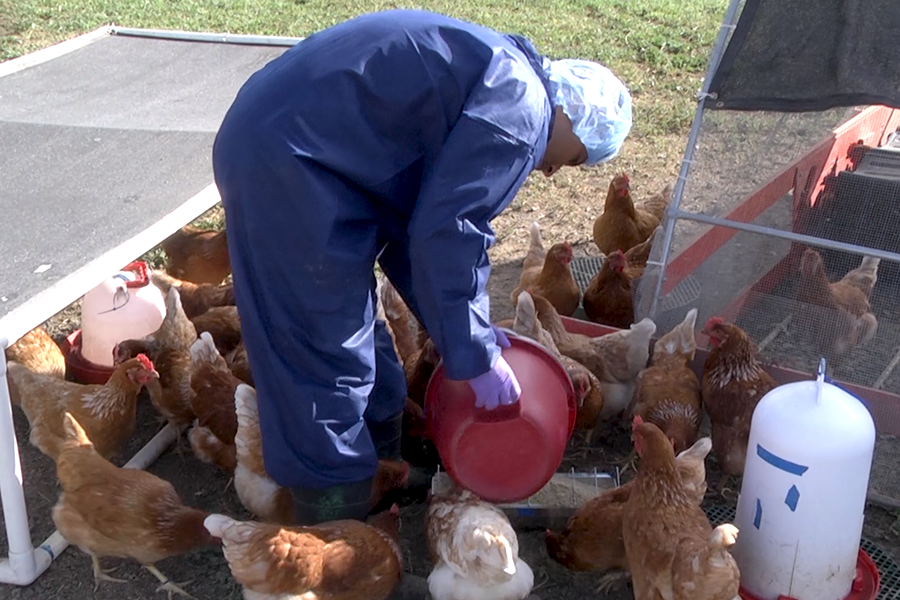
Larvae supplement chicken feed as synthetic methionine phased out of organic use
In a collaborative effort, researchers from the Departments of Civil and Environmental Engineering and Biological Agricultural Engineering and the UC Davis School of Veterinary Medicine have developed a process of growing black soldier fly larvae and introducing them as a dietary supplement for chickens.
Normally, methionine is supplemented via synthetic means — that is, introduced into chicken feed. But in the case of organically raised chicken, the amount of synthetic methionine is limited to two pounds per ton of feed. However, the National Organic Program, the branch of the United States Department of Agriculture that certifies organic products, aims to decrease or even eliminate synthetic methionine for use on organic chickens and eggs.
So why flies?
Researchers have considered Brazil nuts and fish meal to fill the gap of supplemental methionine, but aside from being less cost prohibitive than the former, there is a simplicity in using larvae.
“Remember that birds have a natural inclination to eat insects,” said Maurice Pitesky, a professor in the UC Davis School of Veterinary Medicine. “So we’re just trying to take advantage of that natural inclination.”
“The chickens like it more,” said Lydia Palma, a graduate student in the lab of Jean VanderGheynst, a professor in the Department of Biological Agricultural Engineering. “And the impact of growing insects on the environment is less than that of growing crops like soy and corn.”
VanderGheynst’s lab designed the larval breeding system. Initially a senior design project, the black soldier fly larvae was not originally a focus of VanderGheynst’s. However, once it showed feasibility, the idea took off.
“The project was shown at the [Engineering Design] Showcase and had a lot of interest,” said Matthew Paddock, another graduate student in VanderGheynst’s lab. “She took the senior design project as a proof of concept and used it to raise additional funds [for the current project].”
Black soldier fly larvae are distinct from common house and blow flies for two main reasons. They have a longer pupal phase than the latter, typically 20-30 days compared to 3 days. This means that BSFL can grow larger than other types of larvae. In addition, adult black soldier flies have no mouths and therefore cannot transmit disease, allowing for safe, large-scale breeding.
While the eggs are not laid in lab, the entire larval stage, from hatching to harvesting, takes place within carefully designed plastic bags. The bags contain their food, almond shell hulls, fertilizer for nitrogen content and hoses for air intake and outflow. The bags can sustain hundreds of larvae at a time and grow within a climate controlled environment that governs humidity, temperature and oxygen flow. Almond shells, most commonly used for animal bedding, are a byproduct of almond harvesting and can be a cheap source of food for the
larvae. The tailings from the larvae are also reusable compost, a bonus to the larvae themselves being high in protein.
After two or three weeks, the larvae will begin to pupate, or transition to their adult phase, and in turn “self-harvest themselves”.
“The black soldier flies will actually crawl into a dark area when it is pre-pupating,” Palma said. “In a scaled-up facility, you would probably want to utilize that part of their life cycle to collect them.”
This method of harvesting is more efficient than the alternative: sifting manually through the tailings and collecting the larvae individually. Once collected, the larvae are killed via freezing, dried out, and ground up to be mixed in the chicken feed.
For the experiment to be considered successful, Pitesky and his team must make sure that there is no significant difference between the hens that have eaten the BSFL enriched meal and those that have not. One indicator is in the taste and quality of eggs.
“We’re making sure the shells are still of the same quality as those from hens that are not fed the soldier fly larvae,” Pitesky said. “We’re checking to see if the fatty acid profile in the yolk are the same or equivalent… and finally, we’re trying to make sure that there are no flavor differences.”
The team have carried out a number of taste tests around campus, using a control egg and an egg from a BSFL-fed chicken. Pitesky’s group plans to announce preliminary results next spring at the Western Poultry Disease Conference in Salt Lake City, with a peer reviewed article to be published the following fall.
Written By: Dylan Hendrickson — science@theaggie.org



